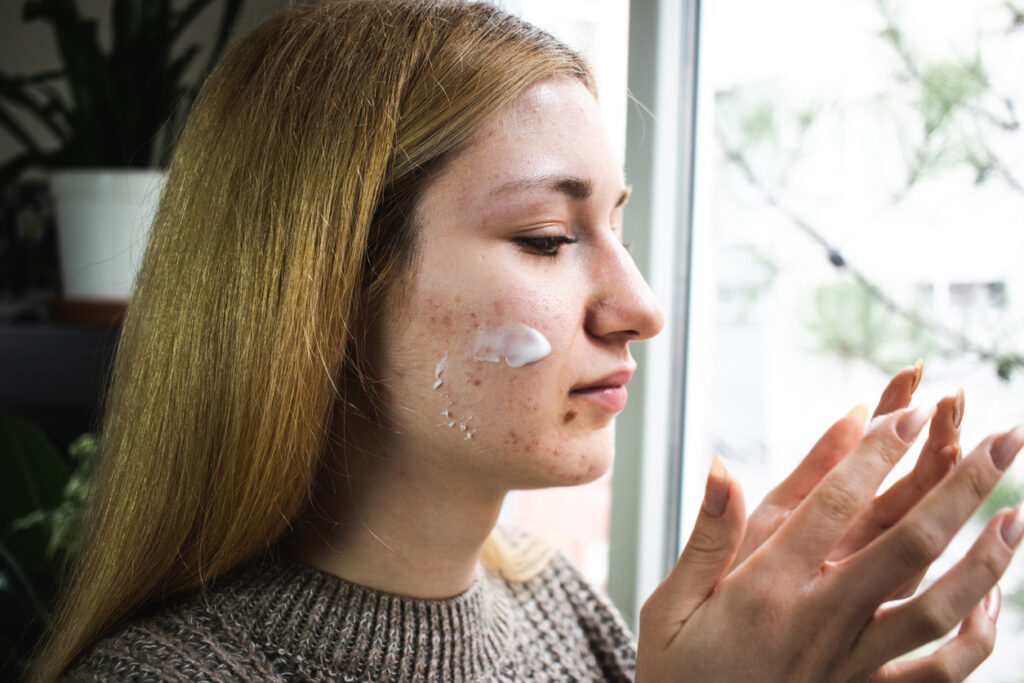Clascoterone cream 1% (Winlevi, Sun Pharma) reduces sebum production and demonstrates excellent stability when used with other commonly prescribed topical acne treatments, according to new data presented at the 2024 Fall Clinical Dermatology Conference in Las Vegas, NV.
In addition, clascoterone cream 1% reduced acne severity in people with darker skin tones, an under-represented population in studies of acne medications.
Clascoterone cream 1% is the first and only androgen receptor inhibitor indicated for the topical treatment of acne vulgaris in patients 12 and older.
Researchers presented 12-week interim results from a yearlong study of the effect of clascoterone cream 1% on facial sebum production in patients with acne. The study’s primary objective and efficacy endpoint was reduction in casual facial sebum levels, as measured by a sebumeter. The study was also designed to assess the ability of clascoterone cream 1% to reduce the Investigator’s Global Assessment (IGA) score, a scale designed for investigators to assess the level of facial acne (0 = clear, 1 = almost clear, 2 = mild, 3 = moderate, 4 = severe). Other study objectives and efficacy endpoints included inflammatory and noninflammatory acne lesion counts, and investigator-assessed oily appearance, pore size, and facial shine; the latter three endpoints were assessed on a five-point scale (0 = none, 1 = minimal, 2 = mild, 3 = moderate, 4 = severe).
Among the 40 participating patients, the mean age was 20.9 years; most patients were female (60%) and White (63%). All patients entered the study with mild (57.5%) or moderate (42.5%) acne, as well as a mean sebumeter reading of 115.9 ± 50.5.
There were significant reductions in sebumeter measurements following use of clascoterone cream 1% at six (-22%), 10 (-19%), and 12 weeks (-27%). They also observed significant improvements in facial oily appearance after four weeks of clascoterone cream 1% treatment (-8%), with continued improvement through 12 weeks (-40%). Similarly, patients’ pore size improved significantly after six weeks (-13%), and continued to improve through 12 weeks (-23%). Additionally, facial shine levels significantly improved after four weeks (-9%) with continued improvement through 12 weeks (-39%).
By Week 12, patients using clascoterone cream 1% experienced a statistically significant 29% reduction in IGA score. Use of clascoterone cream 1% also resulted in significant reductions in the numbers of inflammatory and noninflammatory lesions (-48% and -40%, respectively) after four weeks, with continued improvement through 12 weeks (-54% and -34%, respectively). Clascoterone cream 1% was well tolerated through Week 12, with no reports of adverse reactions.
‘While clascoterone cream 1% is known to target androgen in the skin, an effect that impacts sebum levels and the subsequent acne cascade, this is the first clinical study to actually show a reduction in measured facial sebum production following its use,” says lead investigator and TDD Editorial Advisory Board Member Zoe D. Draelos, MD, of Dermatology Consulting Services, PLLC, in High Point, NC. “These data support evidence from prior clascoterone studies which showed reductions in the number of inflammatory and noninflammatory lesions, and overall efficacy and tolerability.”
Clascoterone Cream 1%: Stability in Combination Therapy Data
Dr. Draelos and colleagues also reported results from a study assessing the stability of clascoterone cream 1% when layered with other topical acne medications such as tretinoin cream 0.025%, adapalene gel 0.3%, dapsone gel 7.5%, azelaic acid 15%, benzoyl peroxide 5%/clindamycin 1%, benzoyl peroxide 2.5%/adapalene 0.1%, and benzoyl peroxide encapsulated 5%. Each of these medications were placed separately on individual microscope slides with clascoterone cream 1% and incubated for eight hours at 37° Celsius. Material from the slides was extracted for analysis via high-performance liquid chromatography-mass spectrometry (HPLC-MS).
Clascoterone cream 1% concentrations remained stable after layering with other acne medications. The percentage of clascoterone cream 1% recovered after layering ranged from 98% to 119%, indicating that none of the acne medications evaluated induced degradation of clascoterone cream 1% when used in combination.
“In addition to validating clinical evidence showing reductions in sebum production with clascoterone cream 1%, this in vitro study confirms what we see with patients in practice, where clascoterone can be used in combination with other commonly used acne medications such as topical retinoids, topical antibiotics, and/or benzoyl peroxide,” adds Dr. Draelos.
Clascoterone Cream 1%: Skin of Color Data
A separate team of researchers presented 16-week interim results from a 56-week, single-center, open-label pilot study evaluating the efficacy and safety of clascoterone cream 1% in 10 patients (mean age 24 years) with skin of color (Fitzpatrick skin types IV, V, and VI) and moderate-to-severe facial acne. The study met its primary endpoint, with seven (78%) patients achieving an IGA score of 0 (clear) or 1 (almost clear) at Week 16. The study also met its secondary endpoints at Week 16, including significant reductions in inflammatory (91.8%), noninflammatory (90.9%), and total lesions (90.9%). Investigator- and participant-assessed tolerability parameters were absent or minimal at most time points through Week 16. There were no reports of adverse events during the 16-week interim analysis period.


